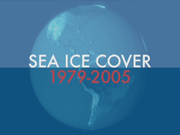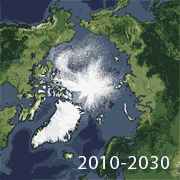A Future for Sea Ice?
The last four years have seen the greatest reductions in sea ice since the advent of satellite records in the 1970s. Will this trend continue?
Most climate models project continued sea ice losses. As such, scientists are concerned that the formation of new sea ice in the winter will not keep up with the rate of melting in the summer.
Are Climate Models Reliable?
Climate models are not precise tools, but provide reasonable approximations of how climate may change under certain assumptions. All models have some degree of uncertainty. That’s why researchers analyze a wide variety of models.
Nevertheless, all existing climate models predict that the Arctic will be much warmer by the end of this century and that the area covered with sea ice will shrink substantially. Several models predict an ice-free Arctic Ocean during the summer. This would be a dramatic change to global ecosystems as well as to Arctic wildlife and residents.

- Click to view animation

- Use the arrows to navigate through the images
- Projected Sea Ice Extent 2010-2090
- Each of the images above is a synthesis of five climate models. Each model projects sea ice loss, but at different rates — ranging from a 10% to 100% loss.
- Arctic Climate Impact Assessment © Clifford Grabhorn/Grabhorn Studio
